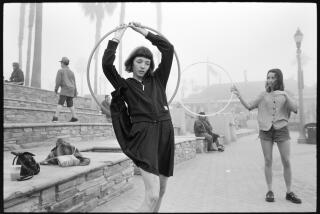Turning Your Flashy Hobby Into Real Art
- Share via
Let’s say you’ve made the decision to take your photography to the next plateau. You’re striving for perfection. Your hobby is turning into an art.
New words are popping into your vocabulary: archival, tonal range, zone system, cold light heads. You even consider buying a 4-by-5-inch view camera for those picturesque scenes along Pacific Coast Highway. The books multiplying on your shelves are written by such photographers as Adams, Weston, Uelsmann, Porter, Newman, Avedon and Porter. You’re hooked.
If your trips to the local camera store or 1-hour lab aren’t giving you the fine-art fix you need, Fred Picker may have an answer for you.
His name is a household word among today’s top art photographers. He is the owner of Zone VI Studios Inc., a mail-order supplier and maker of high-quality, handmade, hard-to-find photographic specialty items, including archival print washers, electronic static brushes and compensating enlarging timers.
The 15-year-old business has grown from a one-man operation working out of a 200-square-foot garage in White Plains, N.Y., to its current 12 employees in a 6,000-square-foot facility in Newfane, Vt.
“I started it in 1972,” said Picker, 61. Before that, he was a commercial photographer doing architectural and industrial photography, “and I was teaching workshops in photography.
“There were several pieces of equipment that I had designed for myself and built at home (mostly print washers). One of the things I did that started the ball rolling for the workshops was writing a little booklet to help people get past the technical stage.”
He reproduced the Zone VI Workshop Book on loose-leaf, mimeographed paper and gave it to students. Petersen Photographic Publishing picked it up and serialized it, giving the business a big push. Amphoto has since published the book and sold more than 400,000 copies.
“People started getting in touch with me to find things like cold light heads (a type of light source for enlargers) and washers that I had mentioned in the book,” Picker said.
In 1982, he expanded and moved the business to Vermont, near the area where he grew up. “We’ve developed a lot of new products since then,” he said, “and I guess our most dramatic products were developed with the help of one of our customers: Dr. Paul Horowitz, a Harvard physicist.
“We decided we would tackle all the areas of photography that are poorly equipped. One of them was meters to get the right exposure on the film. The reason that meters are lousy is they are linear. They follow the amount of light striking them in exact proportion--which is terrific, except that film doesn’t. Film is very sensitive to ultraviolet light and very insensitive to infrared, but the meter sees them the same.
“So you get the same exposure or density on the film if you photograph a blue sky or green grass, which can cause as much as a three-stop difference in exposure.
“The situation was so bad that in my newsletter I said, ‘Don’t use a meter. Use a system that I devised.’ ”
Horowitz developed a modification whereby the meter follows the film curve exactly. It works for both black-and-white and color film.
Horowitz and Picker also collaborated on a way to get consistent light on the paper when making an enlargement.
“Enlargers were not very consistent,” Picker said. “Cold light sources wander because of the gas in the tubes. Paul developed a stabilizer for the light source, which used a photocell that in turn levels the amount of light hitting the printing paper.”
Other interesting items from Zone VI include a compensating development timer, electronic static brush, archival print and film washers, viewing filters, compensating enlarging metronome and print flattener. (To obtain a catalogue or information, contact Zone VI Studios Inc., Newfane, Vt. 05345-0219, (802) 257-5161.)
Even more unusual than his varied line of products is Picker’s lifetime guarantee on the equipment he makes.
“I think if we can’t build a camera well enough so you never have to buy another camera, then we don’t deserve the business,” he said.
More to Read
Sign up for our Book Club newsletter
Get the latest news, events and more from the Los Angeles Times Book Club, and help us get L.A. reading and talking.
You may occasionally receive promotional content from the Los Angeles Times.










